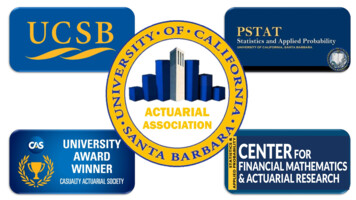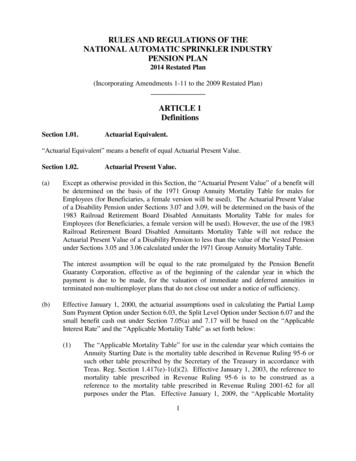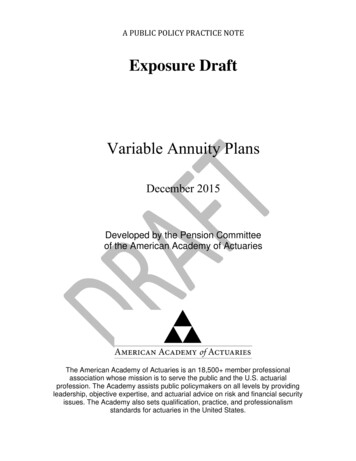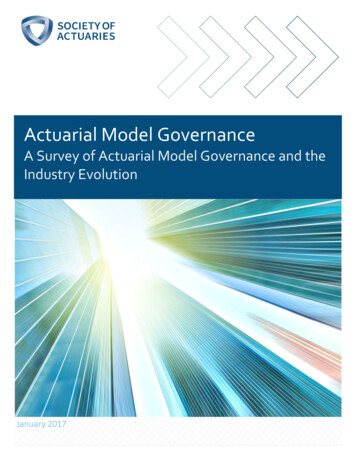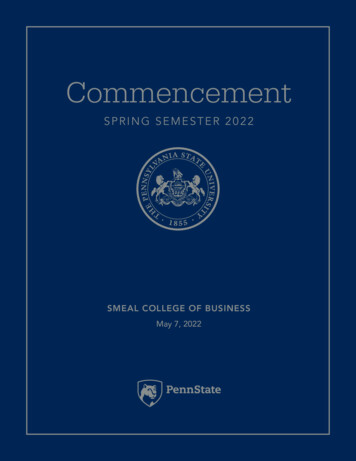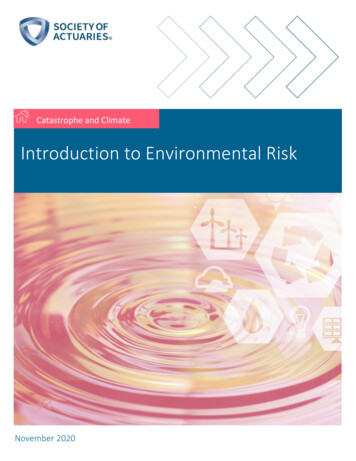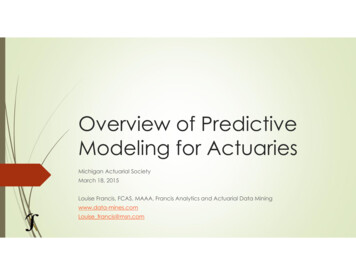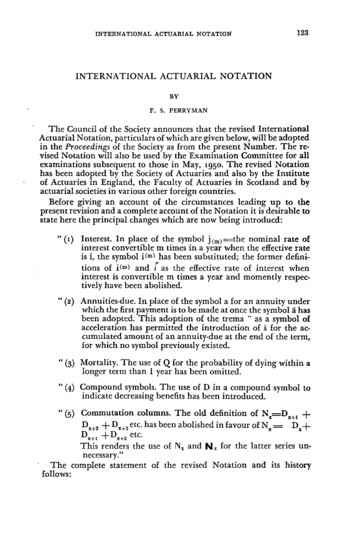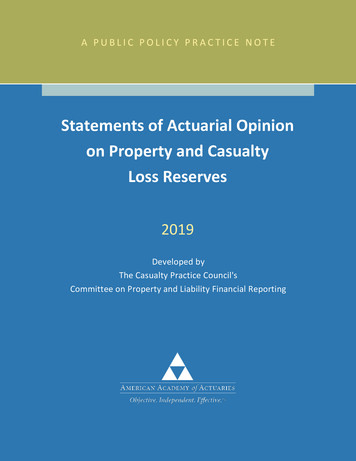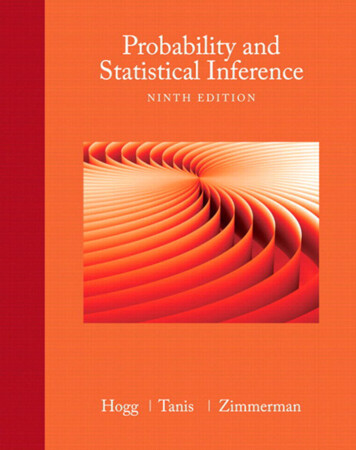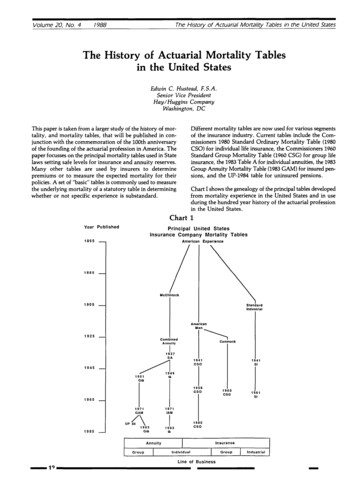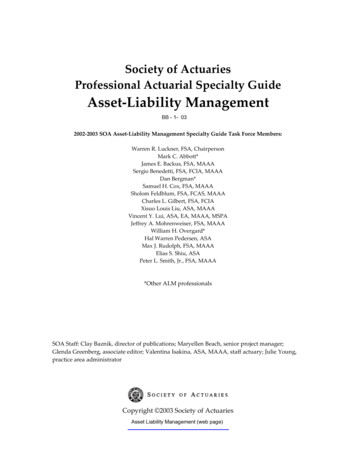
Transcription
Society of ActuariesProfessional Actuarial Specialty GuideAsset-Liability ManagementBB - 1- 032002-2003 SOA Asset-Liability Management Specialty Guide Task Force Members:Warren R. Luckner, FSA, ChairpersonMark C. Abbott*James E. Backus, FSA, MAAASergio Benedetti, FSA, FCIA, MAAADan Bergman*Samuel H. Cox, FSA, MAAASholom Feldblum, FSA, FCAS, MAAACharles L. Gilbert, FSA, FCIAXisuo Louis Liu, ASA, MAAAVincent Y. Lui, ASA, EA, MAAA, MSPAJeffrey A. Mohrenweiser, FSA, MAAAWilliam H. Overgard*Hal Warren Pedersen, ASAMax J. Rudolph, FSA, MAAAElias S. Shiu, ASAPeter L. Smith, Jr., FSA, MAAA*Other ALM professionalsSOA Staff: Clay Baznik, director of publications; Maryellen Beach, senior project manager;Glenda Greenberg, associate editor; Valentina Isakina, ASA, MAAA, staff actuary; Julie Young,practice area administratorCopyright 2003 Society of ActuariesAsset Liability Management (web page)
SOA Professional Actuarial Specialty Guide: Asset-Liability ManagementTable of ContentsAsset-Liability Management . 1INTRODUCTION.1WHAT IS ALM?.2THE ROLE OF THE ACTUARY .3THE ROLE OF SCIENTIFIC PRINCIPLES AND ACTUARIAL STANDARDS OF PRACTICE .3RELEVANT PROFESSIONAL ORGANIZATIONS .4FORMAT OF THE GUIDE'S CONTENT .5REFERENCES.5Basics in Financial Economics Relevant to ALM . 9INTRODUCTION.9References—Introduction.9OVERVIEW OF FINANCIAL MARKETS .10Reference—Overview of Financial Markets .10RISK/RETURN TRADEOFF MODELS .10References—Risk/Return Tradeoff Models .11BEGINNING DERIVATIVES .11References—Beginning Derivatives .12THE EFFICIENT FRONTIER AND ASSET ALLOCATION.13References—General .14References—Property/Casualty .15References—Pensions.15BEHAVIORAL FINANCE .16References—Behavioral Finance .16Tools and Techniques. 18BASIC RISK MANAGEMENT METRICS .18General Introduction of Duration and Convexity .18General Definition.18Variations of the General Definition of Duration .19Macaulay Duration.20Modified Duration .20Effective Duration .21Other Related Concepts.22Definition of Key Rate Duration or Partial Duration .22Applications of Duration .24i
SOA Professional Actuarial Specialty Guide: Asset-Liability ManagementWeaknesses of Duration as a Risk Measure .24References—Fixed and Certain Cash Flows .25References—Interest-sensitive Cash Flows.26References—Hedging with Swaps, Futures and Options.28References—Multivariate Models.29IMMUNIZATION AND DEDICATION .29References—Fixed and Certain Cash Flows .30References—Interest-sensitive Cash Flows.31References—Hedging with Swaps, Futures and Options.32References—Multivariate Models.33ADVANCED RISK MANAGEMENT METRICS .33References—Advanced Risk Management Metrics .35FINANCIAL MARKET MODELING .36Arbitrage-Free Interest Rate Models.38Interest Rate Modeling with Default Risk .41Equity Models .41Data Issues .42Role of Inflation .43Practical Problems.43Discrete-Time vs. Continuous-Time Models .44Interpretation of Financial Market Models.44Reference—Interpretation of Financial Market Models .45References—Discrete-Time Term-Structure Models.45References—Survey of Continuous-Time Term-Structure Models.46References—Books.46DERIVATIVES .49General Functionality .49Derivatives Pricing .51Derivatives Application in ALM .51References—General Functionality .52References—Derivatives Pricing .53Recommended Journals .54Credit Derivatives—Credit Default Swap.55Other New Corporate Bond Products .56References .57Selected Web Sites Regarding Research on Credit Risk Analysis .58FAIR VALUE OF LIABILITIES .58Background.58References—Fair Value of Liabilities, Background .59Insurance Liabilities .59References—Draft Accounting Standards.61ii
SOA Professional Actuarial Specialty Guide: Asset-Liability ManagementReferences—Actuarial Task Force Reports .61References—Theoretical Readings and Examples.62References—Other Readings.65Pension Liabilities .66References—Pension Liabilities .67PERFORMANCE MEASUREMENT AND BENCHMARKING .68Portfolio Manager Evaluation.70Investment Income Allocation .71Reference—General .73References—Portfolio Manager Evaluation.73References—Investment Income Allocation .73Applications of ALM . 74CORPORATE ALM .74References .75ALM IN PRODUCT DEVELOPMENT .78References—General dexed le Premium Deferred Annuities.81References—Variable Annuities .82References—Life, Equity-Indexed .82References—Retirement Plans .82PROPERTY AND CASUALTY INSURANCE.83Early Studies .83Term Structure of Interest Rates .84Common Stock Durations .84Dynamic Financial Analysis (DFA).84Expected Policyholder Deficit .85Coherent Risk Measures.86Risk-Based Capital Requirements .86Federal Income Taxes .86Asset-Liability Efficient Frontier .86References .87PENSION PLAN ALM .93References—Pension Plan ALM.94iii
SOA Professional Actuarial Specialty Guide: Asset-Liability ManagementACCOUNTING AND REGULATORY ISSUES APPLICABLE TO ALM .95FAS 133.95AICPA Standards .95U.S. Insurance Statutory Issues .96International Accounting Standards .96American Academy of Actuaries (AAA) .96Actuarial Standards Board (ASB) .96European Union (EU).96Enterprise Risk Management Commentary . 97References .98Appendix . 99iv
SOA Professional Actuarial Specialty Guide: Asset-Liability ManagementCopyright 2003 Society of ActuariesAsset-Liability ManagementIntroductionThis specialty guide is a background reading list reference for the practice ofasset-liability management (ALM). It is intended to provide guidance to anyoneseeking to gain knowledge regarding ALM, especially with respect to its applicationto financial security systems such as life or health insurance, property and casualtyinsurance and pensions. Some sections have property/casualty-specific and pensionspecific references shown separately, and special sections are devoted toproperty/casualty-specific references and to pension-specific references. We hopethat this guide also will be useful to an audience beyond the actuarial professionseeking to understand a challenging but increasingly important subject.The guide should be viewed as a preliminary road map for any practitionerseeking direction to enhance his or her knowledge of ALM. No particular level ofexpertise is assumed, although a basic understanding of the investments available toa financial institution is helpful. To make the guide as widely useful as possible, wehave attempted to indicate the level of difficulty of each reference (basic,intermediate, advanced).Recently, there has been much discussion regarding the concept of enterpriserisk management (ERM). ERM is a broader concept than ALM. ERM can be viewedas a comprehensive and integrated process of identifying, assessing, monitoring andmanaging the risk exposure of an organization, ideally through a formalorganizational structure and a quantitative approach. The goal of ERM is tominimize the effects of risk on an organization's capital and earnings, and to betterallocate its risk capital. Thus, ERM considers the broad range of risks associated withoperating a business, including financial, strategic, operational and hazard risks.Because financial institutions thrive on the business of risk, they are good examplesof companies that can benefit from effective ERM. ALM is a significant componentof ERM because it is an important process in addressing financial risk. This guide isprimarily concerned with ALM, but includes a short section on ERM.For additional information regarding ERM, see the Society of Actuaries (SOA)Risk Management Task Force Web site. (rmtf.soa.org) The work of the task force alsoinvolves a review of other risk management issues including economic capitalcalculation and allocation, equity modeling, extreme value models, health riskmanagement, policyholder behavior in the tail, pricing for risk, risk-basedcapital covariance, risk management future and strategy, and risk management metrics.ALM Specialty Guide 20031
SOA Professional Actuarial Specialty Guide: Asset-Liability ManagementWhat Is ALM?ALM is the practice of managing a business so that decisions and actionstaken with respect to assets and liabilities are coordinated. ALM can be defined asthe ongoing process of formulating, implementing, monitoring and revisingstrategies related to assets and liabilities to achieve an organization's financialobjectives, given the organization's risk tolerances and other constraints. ALM isrelevant to, and critical for, the sound management of the finances of anyorganization that invests to meet its future cash flow needs and capitalrequirements.Traditionally, ALM has focused primarily on the risks associated withchanges in interest rates. Currently, ALM considers a much broader range of risksincluding equity risk, liquidity risk, legal risk, currency risk and sovereign orcountry risk.ALM is practiced in diverse settings: Derivative dealers manage their long and short positions.Bankers coordinate the repricing horizons of their assets and liabilities.Pension plans adjust their investments to mirror the characteristics oftheir liabilities with respect to interest rates, equity returns and expectedchanges in wages.Insurers select investment strategies to ensure they can supportcompetitive pricing and interest crediting strategies.While each of these involves the application of ALM techniques to aparticular financial problem, the implementations in these situations may bear littleresemblance to each other. The derivative dealer must make many decisions duringthe course of a trading day, and is therefore likely to use a technique such as Valueat Risk (VAR) based on intra-day market price volatility that can be used quicklyand easily. Simulation modeling of those risks is a luxury not available due to timeconstraints. On the other hand, insurers typically manage ALM risks usingsimulation models that may take weeks or months to operate and validate. Dailyapplication of risk limits is neither feasible nor necessary. Similarly, bankers' ALMrisks are primarily those that will show up in profits in the near- to medium-termfuture, so their approach to ALM may emphasize short-term income and expenses,while a pension plan, taking a longer view, may focus on the present value ofrequired contributions.ALM Specialty Guide 20032
SOA Professional Actuarial Specialty Guide: Asset-Liability ManagementThese are all valid applications for ALM, but the appropriate tools andmeasurements for each situation can differ significantly. The choice of appropriatetools and measurements depends in turn on identifying the primary risk of concern.For example, in a pension fund, risks include levels of contributions, expenses, ornet income, and balance sheet items. Minimizing risk in any of these areas mayincrease risk to others. Senior management of a financial organization often needshelp in focusing on the primary risk.The readings listed in this introductory section are intended to provide abasic overview of most topics and concepts in ALM. The sections that follow surveythe broad range of ALM tools and applications that exist today. The approach toALM in a particular situation must be chosen with regard to available time, humanresources, capital, information and management philosophy.The Role of the ActuaryActuaries measure, model and manage risk. Risk associated with the ALMprocess is one of the most important risks faced by many financial security systems.The current professional actuarial education and qualification process providesactuaries knowledge and understanding of assets and liabilities and how they areinterrelated. This knowledge includes an understanding of the operation of financialmarkets, the instruments available and the use of synthetic instruments. Financialreporting and product development actuaries are expected to understand therelationship of the company's assets to its liabilities so as to reflect the risks inherentin the business and thereby enhance its profitability and solvency. Insurance andinvestment products are continually being redesigned, updated, expanded andreplaced. The practicing actuary considers these changes and how they affect thecompany. The actuary must be able to communicate such changes to the company'sportfolio managers (or be part of such portfolio management). The coordination ofproduct development, investment operations and financial reporting is essential fora successful financial security system. Actuaries are well prepared througheducation and experience to perform this role.The Role of Scientific Principles and Actuarial Standards of PracticeActuarial standards of practice provide guidance to actuaries as they fulfilltheir various responsibilities in order to ensure that their employers, clients and thepublic interest are well served. As described by the Actuarial Standards Board (ASB)in the United States: "Standards of practice serve to assure the public that actuariesare professionally accountable. At the same time, standards provide practicingactuaries with a basis for assuring that their work will conform to generally acceptedALM Specialty Guide 20033
SOA Professional Actuarial Specialty Guide: Asset-Liability Managementprinciples and practices." Thus, actuarial standards of practice are an importantreference for ALM work, as well as any other actuarial task.Actuarial standards of practice are established by the ASB in the UnitedStates and by the Canadian Institute of Actuaries (CIA) in Canada. The standardsthat have been established, or are in the process of being established (exposuredrafts or discussion drafts), by the ASB can be viewed by accessing the ASB Website at www.actuarialstandardsboard.org. The standards established, or in theprocess of being established, by the CIA can be viewed by accessing the CIA Website at www.actuaries.ca and clicking on "Publications" and then selecting "BlueBook (Standards)."To assist the ASB and the CIA in developing standards of practice, the SOAhas formed a number of committees and task forces to articulate an intellectual andscientific basis for such standards. The SOA Task Force on Asset/LiabilityManagement Principles is in the process of articulating that basis for ALM. The goalis to have a final draft of a principles document completed during 2003. The firstpublication of the document may be an exposure draft.Relevant Professional OrganizationsThere are a number of organizations that provide information that might beof value to those interested in learning about ALM. For your information andconvenience the following table lists a few of the key organizations and their Webaddresses.OrganizationAmerican Academy of Actuaries (AAA)Canadian Institute of Actuaries (CIA)Casualty Actuarial Society (CAS)Society of Actuaries (SOA)Association for Investment Management andResearch (AIMR)Global Association of Risk Professionals (GARP)Professional Risk Managers' InternationalAssociation (PRMIA)ALM Specialty Guide 2003Web 4
SOA Professional Actuarial Specialty Guide: Asset-Liability ManagementFormat of the Guide's ContentEach section of the guide includes commentary introducing the topic of thesection and related issues. For most references, the guide identifies the reference'slevel of difficulty. The guide also identifies references that have been part of thesyllabus for SOA or CFA examinations.The appendix lists alphabetically, by author (or source if, for example, thereference is a compilation of papers presented at a conference or seminar), all thereferences included in the guide, and the section(s) in which they are referenced. Theappendix is intended to provide users of the guide an opportunity to navigatethrough the guide based on reference(s) of interest, to identify all the sections inwhich a particular reference appears or to determine the scope of the references.We welcome your suggestions for changes or additional references. Pleasedirect your comments to Julie Young at the SOA office (jyoung@soa.org).ReferencesReferenceBodie, Z., A. Kane, and A. Marcus. 2002.Investments. 5th ed. New York: IrwinMcGraw Hill.Canadian Institute of Actuaries ALMPractitioners Association.Level of DifficultyBasicFocus is life insurance. Thegroup discusses practice-relatedand emerging issues as part ofan ongoing process to exchangeknowledge and develop ALMbest practices.Formed to further education andresearch in ALM and to promotebest practices. The focus of thegroup is life insurance.Canadian Institute of Actuaries WorkingGroup on ALM.Forbes, S., M. Hays, S. Reddy, and K.Stewart. 1993. Asset-Liability Management inthe Life Insurance Industry. Atlanta, GA: LifeOffice Management Association, Inc.Ingram, D., and L. Zacheis. 1994. "AssetLiability Matching," Chapter 22 in LifeInsurance Accounting. 3rd ed. IASA.ALM Specialty Guide 2003CommentsHas been part of the SOA examsyllabus.BasicBasicHas been part of the SOA examsyllabus.5
SOA Professional Actuarial Specialty Guide: Asset-Liability ManagementReferenceLaster, D., and E. Thorlacius. 2000. "AssetLiability Management for Insurers," SwissRe Sigma (June): 7-11.Level of DifficultyBasicOstaszewski, K. 2002. Asset-LiabilityIntegration. M-FI02-1. Schaumburg, IL:Society of Actuaries.Basic toIntermediateRedington, F. 1952. "Review of the Principlesof Life-Office Valuations," Journal of theInstitute of Actuaries 78, Part III: 286-340.IntermediateCommentsHas been part of the SOA examsyllabus. It can be downloadedfrom the Swiss Re Web site,www.swissre.com. (Click on"Research and Publications,""sigma insurance research,""sigma archive," and scroll downto "No. 6, 2000.")Analyzes the ALM process inthe financial intermediationindustry, especially amonginsurers, from the perspective ofwhat is known about capitalmarkets and practiced infinancial engineering. Themonograph strives to define amission for the moderninsurance industry, its place inthe financial intermediationnetwork, and the role of ALM inthat mission. It reflects a positivebias toward philosophy, but alsoreflects the belief thatphilosophical questionsaddressed will eventually provethemselves to be worthy ofpractical consideration.(SOA monographs can bedownloaded for free from:www.soa.org/bookstore/mono.html.)Available in the InvestmentSection Monograph (SOAMonograph M-AS99-2), whichwas published in honor of theSociety of Actuaries 50thanniversary, and includesimportant investment literature.(SOA monographs can bedownloaded for free from:www.soa.org/bookstore/mono.html).ALM Specialty Guide 20036
SOA Professional Actuarial Specialty Guide: Asset-Liability ManagementReferenceShiu, E. 2004. "Matching," in Encyclopedia ofActuarial Science. John Wiley & Sons.Society of Actuaries Risk Management TaskForce.Level of DifficultyBasicCommentsA brief survey of variousmethods for matching assets andliabilities, with a comprehensivelist of references. TheEncyclopedia of Actuarial Science isexpected to be published in2004.The task force has identifiedfour major activities:1. Promotion of actuarialexpertise in areas of riskmanagement.2. Promotion of opportunitiesfor actuaries in the arena ofrisk management.3. Sponsorship of seminars onrisk management.4. Development of new riskmanagement educationalmaterials.Additional information aboutthe work of the task force and itssubgroups is available at:ALM Specialty Guide 2003http://rmtf.soa.org7
SOA Professional Actuarial Specialty Guide: Asset-Liability ManagementReferenceSociety of Actuaries Task Force onAsset/Liability Management Principles."Asset Liability Management Principles."(Not yet available.) Society of Actuaries.Level of DifficultyBasicWilliams, E., ed. 1992. ManagingAsset/Liability Portfolios. Charlottesville, VA:ICFA Continuing Education.BasicALM Specialty Guide 2003CommentsThe
SOA Professional Actuarial Specialty Guide: Asset-Liability Management. ALM Specialty Guide 2003 3. These are all valid applications for ALM, but the appropriate tools and measurements for each situation can differ significantly. The choice of appropriate tools and measurements depends in turn on identifying the primary risk of concern.
